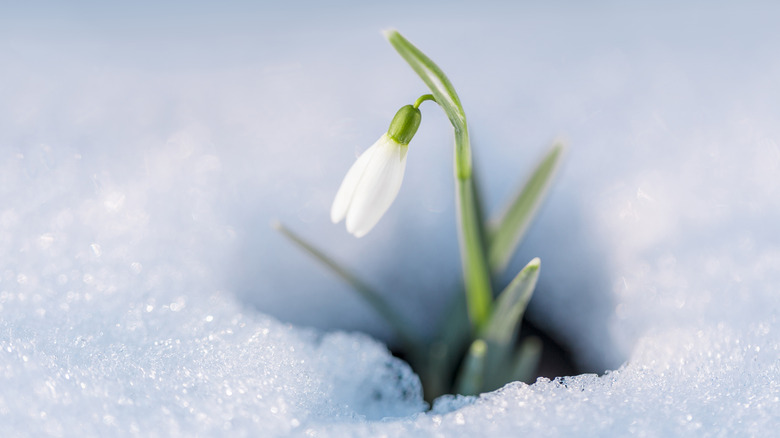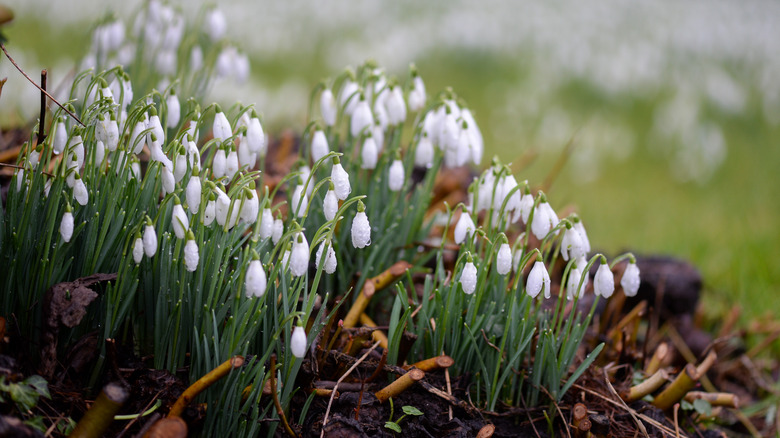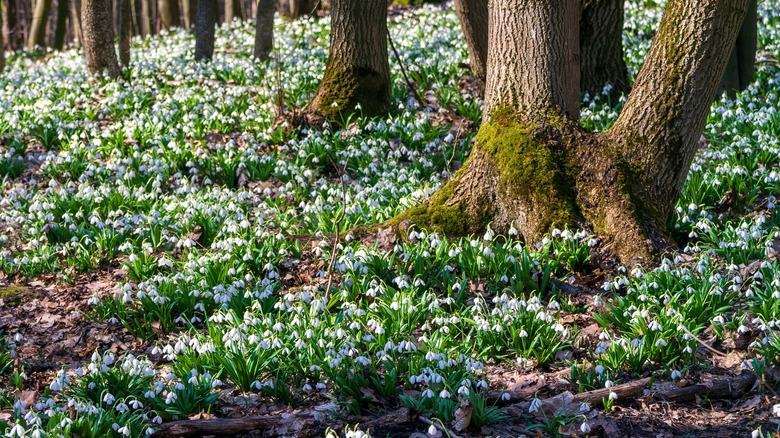Why Are Snowdrops The First Flowers To Bloom In Spring?
As the wheel of the year makes yet another turn, we all start to look forward to the first signs of spring: birds singing, squirrels awakening, and frost giving way to small flowers. Horticulturist and author Getrude S. Wister once said, "The flowers of late winter and early spring occupy places in our hearts well out of proportion to their size" (via Garden Digest). And as the barren scene of winter comes to an end, there's perhaps no better beacon of life than the snowdrop.
In the Victorian language of flowers called floriography, snowdrops actually symbolized death, but they also represent sympathy, hope, rebirth, and renewal. These delicate, drooping white flowers go by a few different names around the world, including snow bells and snow piercers, and across the globe they are adored as one of the very first signs of spring. But what makes these pretty flowers capable of popping up so early? How do they survive amid the still freezing temperatures and melting snow? Here's what you need to know about snowdrops and how you can enjoy these elegant white perennials in your garden every year.
Snowdrops are strong survivors
Snowdrops are a member of the Galanthus genus, a name that means milk flower. Galanthus nivalis, or milk flowers of the snow, bloom year after year and typically go through a dormant phase in winter. The flowers originated in Europe, but found their way to North America and have now become naturalized in more than 15 states, thriving between USDA hardiness zones 3 and 6. In order to bloom, snowdrops require extensive periods of time when temperatures drop below 20 degrees Fahrenheit, explains Penn State Extension.
Unlike many plants, which would typically freeze and die under such cold conditions, snowdrops have specialized proteins in their sap that work like antifreeze and protect their cells from ice crystals. If temperatures dip too far, the plants may sustain some damage, but they'll quickly recover as soon as the warmth returns. Their slender leaves are stiff and sharp, helping the plants push their way through compact snow — hence why the French commonly call the flower perce-neige, or snow piercer. Even the blossoms themselves are perfectly positioned for survival; the droopy downward position of snowdrops protects their pollen from wet conditions, notes a 2022 study published in the journal Plant Signaling and Behavior. When temperatures rise above 50 degrees Fahrenheit, the flowers open upwards just in time to attract the first hungry pollinators.
How to cultivate snowdrops
Snowdrop season is like a beacon of hope to gardeners, reminding anyone who passes by that spring is surely on its way. The flowers are quite easy to cultivate, especially if you live in the central northern portion of the U.S. Purchase or harvest bulbs to plant in fall, about 2 to 3 inches deep in loose, well-drained soil. Snowdrops love to be planted in partial shade under deciduous trees. Planting bulbs on the south or west side of your home is also a good idea, as the ground here will start to thaw faster with the morning sunlight.
Once they've settled into the soil, snowdrops are relatively low-maintenance plants. The key to getting these flowers to bloom is to experience at least one good, strong freeze or a dramatic dip in temperatures every year. Most plants will bloom around mid-February, but some varieties, like Potter's Prelude, will even bloom as early as mid-November, per Lancaster Online. Ants play a crucial role in collecting and distributing the seeds, so avoid culling any anthills until long after your snowdrops have wilted away.


